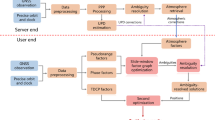Abstract
A frequency domain analysis is presented to optimize the Predictive Least Mean Square (PLMS) algorithm used for wireless channel tracking. Simulation results show that the PLMS offers significant improvement in tracking performance compared to that of the conventional LMS based method. The algorithm parameters should be carefully selected in order to gain such improvements. The objective of this paper is to use frequency domain analysis to determine an expression for the Mean Square Tracking Error (MSTE) and use it to obtain the optimum PLMS algorithm parameters such as step size (μ) and smoothing constant (θ) with numerical optimization methods.
Similar content being viewed by others
References
Proakis, J. G. (1995). Digital communications. McGraw Hill Inc.
Haykin, S. (1996). Adaptive filter theory (3rd ed.). Prentice Hall.
Lindbom L., Ahlen A., Sternad M. and Falkenstrom M. (2001). Tracking of time-varying mobile radio channels. I. The Wiener LMS algorithm. IEEE Transaactions on Communications 49: 2207–2217
Benveniste A., Metivier M. and Priouret P. (1990). Adaptive algorithms and stochastic approximation. Springer-Verlag, New York
Sheikh A.U.H. and Shah S.F.A. (2002). A robust μ opt -LMS algorithm for the tracking of fading channels. Wireless Communications and Mobile Computing 2: 215–223
Gazor S. (1999). Prediction in LMS-Type adaptive algorithms for smoothly time varying environments. IEEE Transactions Signal Processing 47: 1735–1739
Xue Y. and Zhu X. (2001). Optimum wireless channel tracking based on a second order lms algorithm. Electronic Letters 37: 989–990
Xue Y. and Zhu X. (2003). Wireless channel tracking based on a self-tuning second order LMS. IEE Proceedings Communications 150: 115–120
Clark, A. P., & Hariharan, S. (1988). Channel estimation for an HF radio link. In Proceedings of the IERE Conference (Vol. 82, pp. 213–218),
Nasir Q. and Shah S.A. (2005). Predictive LMS for mobile channel tracking. Journal of Applied Sciences 5: 227–340
Jakes W.C. (1974). Microwave mobile communication. Wiley, Newyork
Rappaport T. (2002). Wireless communications: Principles and practicen. New Jersey, Prentice Hall
Nasir, Q. (1994). High speed data transmission over a high frequency channel. PhD Thesis, Baghdad University.
Rutstorm, J. (2005). Simplified Wiener LMS tracking with automatic tuning of the step-size. PhD Thesis, Uppsala University.
Nelder J. and Mead R. (1965). A simplex method for function minimization. Computer Journal 7: 308–311
Kelly C.T. (1999). Iterative methods for optimization. SIAM, Philadlphia, PA
Dennis J. and Woods D. (1987). Optimization on microcomputers: The Nelder-Mead simplex algorithm. In: Wouk, A. (eds) New computing environments: Microcomputers in large-scale computing, pp. Society for Industrial and Applied Mathematics, Philadelphia, PA
Nasir Q. (2006). Self tuned predictive LMS for mobile channel tracking. Journal of Pure and Applied Sciences 3: 49–61
Smith J. (1975). A computer generated multipath fading simulations for mobile radio. IEEE Transactions on Vehicular Technology 24: 39–40
Author information
Authors and Affiliations
Corresponding author
Rights and permissions
About this article
Cite this article
Nasir, Q. Wireless Channel Tracking Based on Optimum Predictive LMS. Wireless Pers Commun 48, 511–519 (2009). https://doi.org/10.1007/s11277-008-9535-9
Received:
Accepted:
Published:
Issue Date:
DOI: https://doi.org/10.1007/s11277-008-9535-9




